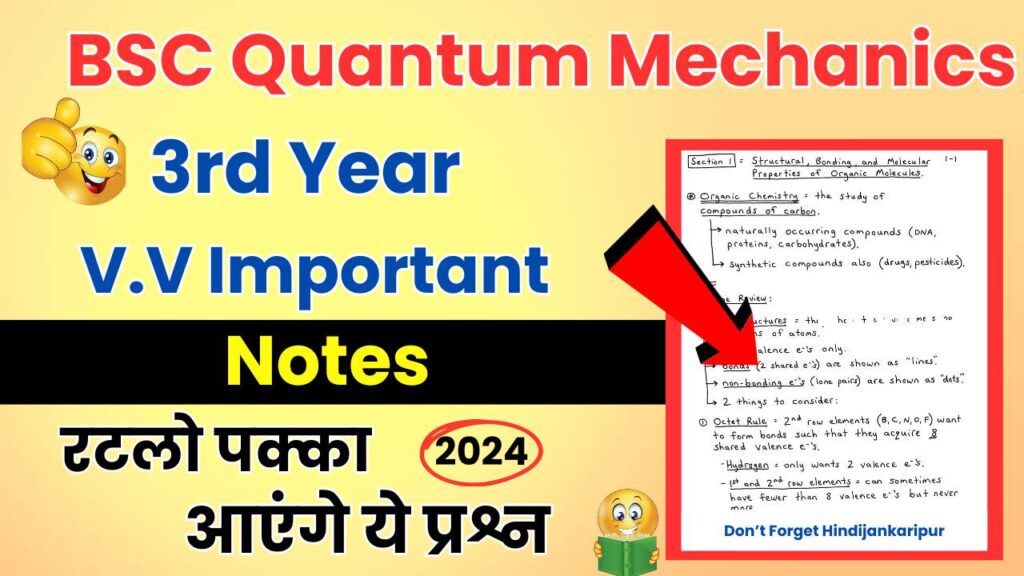Studying Quantum Mechanics BSC 3rd Year Notes is Good for your Exam Preparation. They Can Help You To Cover Maximum Syllabus In Minimum Time.
Quantum Mechanics Is A Difficult Subject if You Lack Knowledge About Its Understanding. In This Post We Have Compiled Some important Quantum Mechanics BSC 3rd Year Notes.

These Important Question Mentioned Here Are Extracted From Previous Year Question Papers And They Help You Learn Important Knowledge about Your Syllabus…
Contents
Quantum Mechanics BSC 3rd Year Notes
| Course | BSC (Bachelor of Science) |
| Subject | Physics |
| Content | Notes |
| Provided | |
| Topc | Quantum Mechanics |
| Provide by | Hindijankaripur |
| Official Site | Hindijankaripur.com |
| Telegram | https://t.me/studentcafeindia |
Experimental Evidence of Quantum Theory
Photoelectric Effect: Demonstrates the particle nature of light, where light can eject electrons from a material.
Compton Scattering: Shows the particle nature of photons and their interaction with electrons.
Matter Waves: Proposed by de Broglie, suggesting that particles exhibit wave-like properties.
Davisson-Germer Experiment: Confirmed the wave nature of electrons through diffraction patterns.
Uncertainty Principle: Introduced by Heisenberg, stating that certain pairs of physical properties, like position and momentum, cannot be simultaneously measured with arbitrary precision.
Schrödinger’s Wave Mechanics
Schrödinger Equation: Fundamental equation of quantum mechanics describing how the quantum state of a physical system changes over time.
Time-Dependent Schrödinger Equation: Describes the evolution of the wavefunction over time.
Time-Independent Schrödinger Equation: Used for systems with a time-independent Hamiltonian to find stationary states.
Wavefunction: Represents the state of a quantum system, with its square modulus giving the probability density of finding a particle in a given position.
Operators in Quantum Mechanics: Physical quantities are represented by operators, which act on the wavefunctions to extract measurable values.
Expectation Values: The average value of a physical quantity in a given quantum state, calculated using the corresponding operator.
Simple Solutions of Schrödinger’s Equation
Particle in a One-Dimensional Box: A fundamental problem where a particle is confined in a box with infinitely high walls. The solutions are sinusoidal wave functions with discrete energy levels.
Potential Steps and Barriers: Analysis of particles encountering potential steps and barriers, leading to phenomena like reflection and transmission.
Harmonic Oscillator: A system where the potential energy is proportional to the square of the displacement. The solutions are Hermite polynomials with quantized energy levels.
Bound State Problems
Infinite Potential Well: A particle confined in a box with infinitely high walls, leading to discrete energy levels and wavefunctions.
Finite Potential Well: Similar to the infinite well but with finite walls, allowing for both bound and unbound states.
Simple Harmonic Oscillator: A system with a quadratic potential, leading to quantized energy levels and wavefunctions that are Hermite polynomials.
Hydrogen Atom: Solving the Schrödinger equation for a hydrogen atom, leading to quantized energy levels and spherical harmonics for the wavefunctions.
Applications of Quantum Theory to Atomic Spectroscopy
Spectra of One-Electron Atoms: Quantum mechanics explains the discrete energy levels observed in the spectra of hydrogen-like atoms.
Frank-Hertz Experiment: Demonstrates the existence of discrete energy states in atoms.
Stern-Gerlach Experiment: Shows the quantization of angular momentum and the existence of electron spin.
Zeeman Effect: Splitting of spectral lines in the presence of a magnetic field, explained by the interaction of magnetic moments with the external field.
Stark Effect: Splitting of spectral lines in the presence of an electric field.
Quantum Mechanics in Three Dimensions
Schrödinger Equation in 3D: Extending the Schrödinger equation to three dimensions, leading to solutions involving spherical coordinates for central potentials.
Angular Momentum: Quantization of angular momentum and the use of spherical harmonics to describe angular parts of the wavefunction.
Hydrogen Atom: Detailed solution of the hydrogen atom problem, leading to quantized energy levels and specific shapes of the wavefunctions.
Quantum Mechanics BSC 3rd Year Notes PDF
Also Read
BSC 3rd Year Organic Chemistry Important Notes 2024!
We hope that with the help of this article you would have got information about Quantum Mechanics BSC 3rd Year Notes.
Friends, how did you like this post, please let us know in the comment section and if you have any questions, then feel free to ask us in the comment box. If you found this post useful please share it with others.